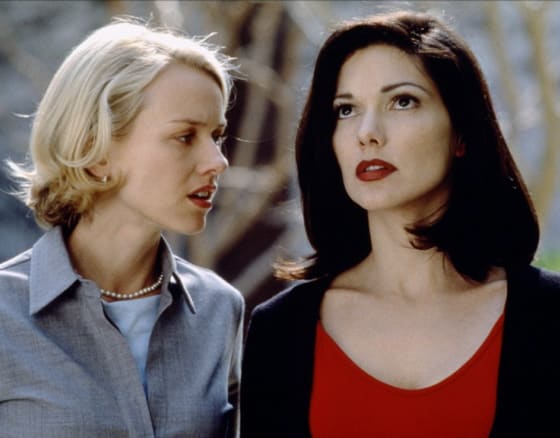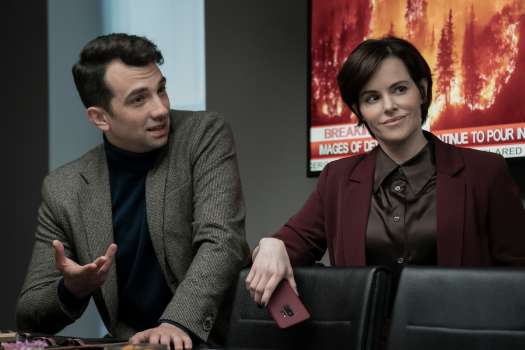Dreams, nightmares and the loss of innocence — or at least the division between idealism and reality — are just a few of the thematic threads holding David Lynch's enigmatic and emotionally rich mystery, Mulholland Drive, together.
It was a failed television pilot for ABC, initially. In the interview segments included with the Criterion Collection Blu-ray, Justin Theroux describes the many battles Lynch had with the network over seemingly arbitrary, mostly regulatory, things like how smoking was handled and their reaction to oblique, unconventional dailies. At the time, The Practice was the number one ABC scripted program, and shows like Friends and Survivor were dominating airwaves. AMC hadn't yet developed original programming and HBOs Six Feet Under was still two or three years away. Though Lynch's Twin Peaks had established an audience desire for abstract, artistic network programming years prior, executives weren't willing to take risk on a show that was so unclear and seemingly critical of the very institution funding it.
While Lynch has never made clear what exactly was shot later to make Mulholland Drive a feature film, the dramatic shift in tone and inclusion of vivid lesbian sex, including nudity, does give us an idea of what might have been added to the two-hour television pilot. This means that the pilot was an amalgamation of four different storylines with a decidedly campy tone. There's the story of Betty (Naomi Watts), an aspiring actress from Deep River, Ontario, befriending amnesia victim Rita (Laura Elena Harring), a presumed famous actress hiding out in her aunt's modest bungalow after a murder attempt and car accident left her stumbling around Mulholland Drive without any memories. And there's the story of the idealistic young director Adam (Justin Theroux), who is pressured by studio execs (and a mysterious cowboy) to cast Camilla Rhodes (Melissa George) in his film. There's also a storyline about a ramshackle hired killer (Mark Pellegrino) that makes a mess of a routine shooting and a story about two detectives (Robert Forster and Brent Briscoe) looking into Rita's car accident.
Without the additional footage, Watts' portrayal of Betty — which, as admitted in the special features, was painful for the actress to deliver at Lynch's request — makes her seem like a terrible actress. And the overly chipper tone accompanying the quest for Rita's true identity has an unsettling falsity (one that's deliberate and obvious to fans of Lynch, particularly when we consider the exaggerated, wooden smiles of the elderly couple Betty encounters at the airport) that executives presumably dismissed as "bad." Similarly, the rather bland secondary storyline associated with Adam (he finds his wife cheating on him) isn't exactly revolutionary within the lexicon of television pilots.
But, as the final product demonstrates, this was all a calculated risk and part of a bigger plan to tell an involved story about the insincerity and false veneer of Hollywood dreams and glamour, using exaggerated parallels and the basic outline of dreams vs. nightmares to heighten the crushing disappointment of Betty's (and presumably Adam's, had the film not dropped his storyline in favour of Betty's arc) decimated idealism. In the context of the film, moments like the audition scene, which revealed Watts to be an astonishingly talented and capable actress, force us to question the reality and tone we'd accepted as the norm. Similarly, the later musical interlude with Rebecca Del Rio, wherein a host repeatedly tells Betty and Rita that everything they see — every bit of touching beauty — is all an illusion, reiterates this notion that what we're seeing, and what Betty dreams of achieving, is all a lie.
The drastic change in style, structure and characterization in the final act impeccably blends form and content to reiterate these central themes. It also features Lynch's trademark symbolism and surrealist imagery, injecting nightmarish images into the story to capture the psychology and horror — while giving the audience topics to discuss and analyze — of what Betty, or Diane, is experiencing. And while this all results in a very powerful cinematic experience, one that communicates a devastating message while challenging our complacency, or even ignorance to, the degree of manipulated reality being presented to us in film, it's also quite clearly a rushed synopsis of Lynch's original concept.
In the pilot footage, Adam is arguably the main character. He gets as much, if not more screen time than Betty, and storylines about the detectives and the hired killer also don't find any real sense of completion beyond implications of how they all fit into the puzzle. In the feature film, all of these storylines are truncated or omitted entirely to service the basic arc of Betty/Diane. Even Rita/Camilla's transition is handled externally, existing to propel the emotional trajectory of our failed actress protagonist. Since the tone and style shift dramatically to serve Lynch's themes and message, it's not an obvious fragment in storytelling, but knowing how Mulholland Drive was constructed does ultimately reveal the contextual irrelevance of many of the early narrative developments outside of Betty and Rita's journey.
But Lynch is a director that doesn't want to spoil the illusion of his films (despite making films that assess the falsity of Hollywood glamour) and refuses to do commentary tracks or allow chapter breaks on DVD and Blu-ray releases of his movies. He leaves the mystery of his images and his unconventional storytelling up to us to interpret in our own way, which has allowed Mulholland Drive to maintain its mystique throughout the years.
This mystery isn't discussed in the special features included with the Criterion Blu-ray (although, there is an essay that touches on it), as Lynch is content to discuss the process of casting and what it was like to work with his actors. Save some of the hints that Watts and Theroux give in their interviews — discussing deliberately bad acting or the network response to the footage — there's really no information given that clarifies the intentions or clearly explains what some of the images (the blue box, for one) represent. And, in many ways, this is a good thing; much of the enjoyment of Mulholland Drive is the experience and the lack of certainty in how to interpret everything we see.
(Criterion)It was a failed television pilot for ABC, initially. In the interview segments included with the Criterion Collection Blu-ray, Justin Theroux describes the many battles Lynch had with the network over seemingly arbitrary, mostly regulatory, things like how smoking was handled and their reaction to oblique, unconventional dailies. At the time, The Practice was the number one ABC scripted program, and shows like Friends and Survivor were dominating airwaves. AMC hadn't yet developed original programming and HBOs Six Feet Under was still two or three years away. Though Lynch's Twin Peaks had established an audience desire for abstract, artistic network programming years prior, executives weren't willing to take risk on a show that was so unclear and seemingly critical of the very institution funding it.
While Lynch has never made clear what exactly was shot later to make Mulholland Drive a feature film, the dramatic shift in tone and inclusion of vivid lesbian sex, including nudity, does give us an idea of what might have been added to the two-hour television pilot. This means that the pilot was an amalgamation of four different storylines with a decidedly campy tone. There's the story of Betty (Naomi Watts), an aspiring actress from Deep River, Ontario, befriending amnesia victim Rita (Laura Elena Harring), a presumed famous actress hiding out in her aunt's modest bungalow after a murder attempt and car accident left her stumbling around Mulholland Drive without any memories. And there's the story of the idealistic young director Adam (Justin Theroux), who is pressured by studio execs (and a mysterious cowboy) to cast Camilla Rhodes (Melissa George) in his film. There's also a storyline about a ramshackle hired killer (Mark Pellegrino) that makes a mess of a routine shooting and a story about two detectives (Robert Forster and Brent Briscoe) looking into Rita's car accident.
Without the additional footage, Watts' portrayal of Betty — which, as admitted in the special features, was painful for the actress to deliver at Lynch's request — makes her seem like a terrible actress. And the overly chipper tone accompanying the quest for Rita's true identity has an unsettling falsity (one that's deliberate and obvious to fans of Lynch, particularly when we consider the exaggerated, wooden smiles of the elderly couple Betty encounters at the airport) that executives presumably dismissed as "bad." Similarly, the rather bland secondary storyline associated with Adam (he finds his wife cheating on him) isn't exactly revolutionary within the lexicon of television pilots.
But, as the final product demonstrates, this was all a calculated risk and part of a bigger plan to tell an involved story about the insincerity and false veneer of Hollywood dreams and glamour, using exaggerated parallels and the basic outline of dreams vs. nightmares to heighten the crushing disappointment of Betty's (and presumably Adam's, had the film not dropped his storyline in favour of Betty's arc) decimated idealism. In the context of the film, moments like the audition scene, which revealed Watts to be an astonishingly talented and capable actress, force us to question the reality and tone we'd accepted as the norm. Similarly, the later musical interlude with Rebecca Del Rio, wherein a host repeatedly tells Betty and Rita that everything they see — every bit of touching beauty — is all an illusion, reiterates this notion that what we're seeing, and what Betty dreams of achieving, is all a lie.
The drastic change in style, structure and characterization in the final act impeccably blends form and content to reiterate these central themes. It also features Lynch's trademark symbolism and surrealist imagery, injecting nightmarish images into the story to capture the psychology and horror — while giving the audience topics to discuss and analyze — of what Betty, or Diane, is experiencing. And while this all results in a very powerful cinematic experience, one that communicates a devastating message while challenging our complacency, or even ignorance to, the degree of manipulated reality being presented to us in film, it's also quite clearly a rushed synopsis of Lynch's original concept.
In the pilot footage, Adam is arguably the main character. He gets as much, if not more screen time than Betty, and storylines about the detectives and the hired killer also don't find any real sense of completion beyond implications of how they all fit into the puzzle. In the feature film, all of these storylines are truncated or omitted entirely to service the basic arc of Betty/Diane. Even Rita/Camilla's transition is handled externally, existing to propel the emotional trajectory of our failed actress protagonist. Since the tone and style shift dramatically to serve Lynch's themes and message, it's not an obvious fragment in storytelling, but knowing how Mulholland Drive was constructed does ultimately reveal the contextual irrelevance of many of the early narrative developments outside of Betty and Rita's journey.
But Lynch is a director that doesn't want to spoil the illusion of his films (despite making films that assess the falsity of Hollywood glamour) and refuses to do commentary tracks or allow chapter breaks on DVD and Blu-ray releases of his movies. He leaves the mystery of his images and his unconventional storytelling up to us to interpret in our own way, which has allowed Mulholland Drive to maintain its mystique throughout the years.
This mystery isn't discussed in the special features included with the Criterion Blu-ray (although, there is an essay that touches on it), as Lynch is content to discuss the process of casting and what it was like to work with his actors. Save some of the hints that Watts and Theroux give in their interviews — discussing deliberately bad acting or the network response to the footage — there's really no information given that clarifies the intentions or clearly explains what some of the images (the blue box, for one) represent. And, in many ways, this is a good thing; much of the enjoyment of Mulholland Drive is the experience and the lack of certainty in how to interpret everything we see.




